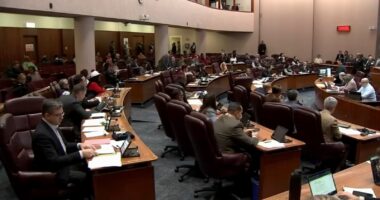Share this @internewscast.com
The ongoing government shutdown has led to a cascade of closures among Head Start centers, creating a childcare crisis for working parents and depriving some of the nation’s most vulnerable children of their early education.
Many centers are now without the federal grant payments they were expecting on November 1st. Some have announced indefinite closures, while others are relying on emergency funds from local governments and school districts to keep their doors open. This disruption means that Head Start students, who often come from low-income families, face homelessness, or are in foster care, are missing their preschool education. These centers not only provide essential learning but also offer two meals daily and critical therapy services.
“Our children love attending school, and being unable to go is truly heartbreaking for them,” expressed Sarah Sloan, the director of several Head Start centers in Scioto County, Ohio. She informed families of the impending closures set for Monday. “This situation is making it difficult for families to ensure their children are safe and cared for during the day, impacting their ability to provide food on the table.”

Initially, a handful of Head Start programs did not receive their anticipated October grants. Currently, 140 programs are still waiting for their annual federal funding. Collectively, these centers have the capacity to support 65,000 preschoolers and expectant parents.
Among those affected are 24 Migrant and Seasonal Head Start centers across five states, which closed their doors as of Monday. Designed to support the children of migrant farmworkers, these centers typically operate 10 to 12 hours a day to fit the demanding farm work schedules of parents.
In states like Florida, Georgia, North Carolina, Alabama, and Oklahoma, children returned home with notices alerting parents to potential closures. These centers, serving more than 1,100 children, will remain closed until the shutdown is resolved, stated Javier Gonzalez, CEO of the East Coast Migrant Head Start Project. Additionally, approximately 900 staff members have been placed on furlough due to these closures.
In the absence of other options for child care, some parents’ only option may be to bring their young child to the fields where they work, Gonzalez said.
Pause in food aid compounds struggles for Head Start families
Many of the families that qualify for the federal preschool program also depend on food aid through the Supplemental Nutrition Assistance Program, better known as SNAP or food stamps. That program also was on track to run dry of money due to the shutdown, although a pair of federal judges on Friday ordered the Trump administration to keep the program running with emergency reserve funds.
That means many Head Start families have been worried about food aid, along with the child care they rely on to make ends meet. A day without child care means a day without work for many parents — and a day without pay.
In Kansas City, Missouri, Jhanee Hunt teaches toddlers at a Head Start site, the Emmanuel Family and Child Development Center, where her 6-month-old son is cared for in another classroom. The center said it can scrape up enough money to stay open for a few weeks, but the money won’t last much beyond November.
At dropoff, she said, parents often are wearing uniforms for fast food restaurants like Wendy’s and McDonald’s. Some work as certified nurse assistants in nursing homes. None have much extra money. The most urgent concern right now is food, she said.
“A lot of the parents, they’re, you know, going around trying to find food pantries,” she said. “A parent actually asked me, do I know a food pantry?”
More than 90% of the center’s families rely on SNAP food assistance, said Deborah Mann, the center’s executive director. One construction company offered to help fill the grocery carts of some families that use the center. But overall, families are distressed, she said.
“We’ve had parents crying. We’ve had parents just don’t know what to do,” Mann said.
Some centers stay open — for now
Launched six decades ago as part of President Lyndon B. Johnson’s War on Poverty, Head Start programs provide a range of services beyond early education, such as medical and dental screenings, school meals and family support to children from low-income households who can’t afford other child care options.
The initiative is funded almost entirely by the federal government, leaving it with little cushion from funding disruptions.
Some that have missed out on grant payments have managed to remain open, with philanthropies, school districts and local governments filling in gaps. Others are relying on fast-dwindling reserves and warn they can’t keep their doors open for much longer.
“If the government doesn’t open back up, we will be providing less services each week,” said Rekah Strong, who heads a social services nonprofit that runs Head Start centers in southern Washington state. She’s already had to close one center and several classrooms and cut back home-based visiting services. “It feels more bleak every day.”
In Florida, Head Start centers in Tallahassee and surrounding Leon County closed Oct. 27, but then reopened the next day thanks to a grant from Children’s Services Council of Leon County. The local school district and churches have stepped up to provide meals for the children.
“It takes a village to raise a child, and our village has come together,” said Nina Self, interim CEO of Capital Area Community Action Agency.
But children in rural Jefferson and Franklin counties, where the agency runs two small Head Start centers, were not as lucky. They’ve been closed since late October.
















